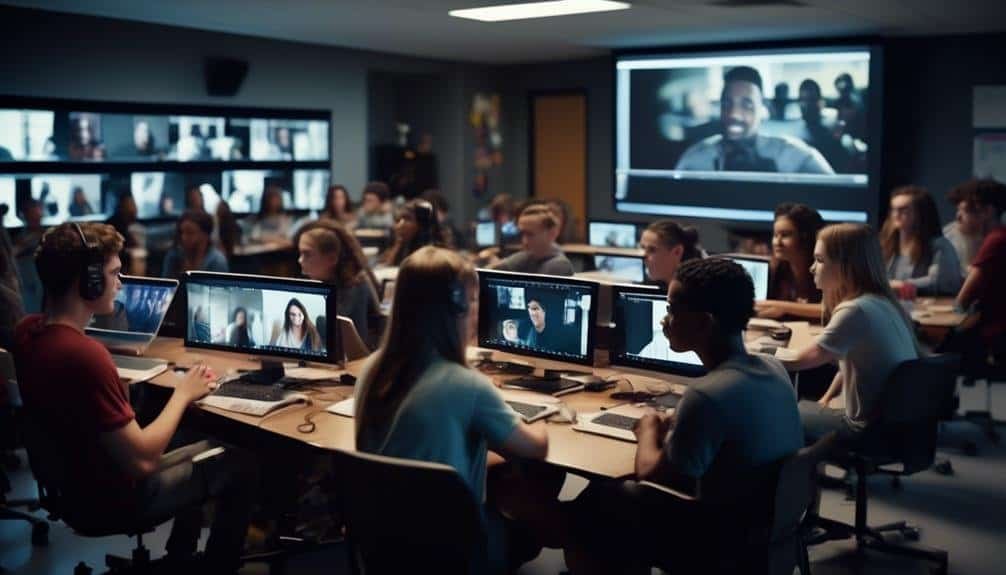Collaboration Tools for Virtual Learning
Imagine a world where students and teachers seamlessly connect, collaborate, and learn together, regardless of physical location. Well, guess what? That world is now a reality, thanks to the wide array of collaboration tools available for virtual learning.
From video conferencing tools that bring everyone face-to-face, to online whiteboard platforms that encourage interactive brainstorming, the possibilities are endless.
But which tools are the most effective? Which ones truly enhance the virtual learning experience?
In this discussion, we will explore the different collaboration tools specifically designed for virtual learning and uncover the key features that make them indispensable in today's digital education landscape.
So, buckle up and get ready to discover the future of education.
Key Takeaways
- Collaboration tools such as video conferencing, online whiteboards, and document collaboration software are essential for virtual learning as they enable real-time communication and editing capabilities.
- Project management applications help streamline workflow and organization in virtual learning by providing features like project scheduling, task tracking, and document sharing.
- Virtual classroom platforms offer live video conferencing, interactive whiteboards, and chat and messaging features to facilitate engagement, interaction, and assessment in virtual learning environments.
- Discussion forums and chat tools play a crucial role in virtual learning by enhancing online engagement, promoting knowledge sharing, and improving critical thinking skills.
Video Conferencing Tools
Video conferencing tools are widely used for remote communication and collaboration, allowing individuals and teams to connect in real-time, regardless of geographical distance. These tools have become essential in virtual learning environments, where face-to-face interactions are limited.
However, there are several video conferencing alternatives available that can enhance the virtual learning experience.
One challenge of virtual learning is ensuring active student engagement. Traditional video conferencing tools often lack interactive features, which can lead to a passive learning environment. To overcome this, educators can explore alternative tools that offer features such as breakout rooms, virtual whiteboards, and real-time collaboration on documents. These features encourage active participation and foster a collaborative learning environment.
Another challenge is managing large class sizes effectively. Traditional video conferencing tools may struggle to accommodate a large number of participants, leading to connectivity issues and limited interaction. Virtual learning platforms that specialize in online education provide solutions for this by offering features like virtual classrooms, attendance tracking, and student engagement analytics.
Online Whiteboard Platforms
Online whiteboard platforms offer a dynamic and collaborative space for virtual learning. These platforms provide an interactive and engaging environment for online brainstorming and interactive collaboration. With the ability to share ideas, draw diagrams, and work together in real-time, students and educators can enhance their learning experience.
One popular online whiteboard platform is Miro. Miro allows users to create and share whiteboards where they can collaborate on projects, brainstorm ideas, and visualize concepts. Its intuitive interface and extensive set of features make it a valuable tool for virtual classrooms.
Another notable platform is Jamboard, developed by Google. Jamboard enables users to create and collaborate on a virtual whiteboard. With its touchscreen capabilities, users can write, draw, and add images to the board, making it an ideal platform for interactive discussions and group activities.
In addition to these platforms, other online whiteboard tools like AWW App, Explain Everything, and Sketchboard offer unique features that cater to different learning needs. These platforms allow users to communicate ideas visually, fostering creativity and critical thinking skills.
Document Collaboration Software
Document collaboration software offers you real-time editing capabilities, allowing multiple users to work on a document simultaneously.
With version control features, you can track changes, compare revisions, and easily revert to previous versions if needed.
Additionally, these tools provide seamless file sharing, enabling you to collaborate and share documents effortlessly with colleagues or classmates.
Real-Time Editing Capabilities
Collaborative writing has never been easier with the real-time editing capabilities offered by document collaboration software. With these tools, you can seamlessly work together with others to create and edit documents in real-time, regardless of your physical location.
Here are five key benefits of real-time editing capabilities:
- Instant updates: Changes made by any collaborator are instantly reflected on the document, allowing everyone to see the most up-to-date version.
- Simultaneous editing: Multiple users can edit the same document simultaneously, fostering collaboration and reducing the time spent on revisions.
- Commenting and feedback: Users can leave comments and provide feedback directly on the document, promoting interactive learning and constructive discussions.
- Version control: Document collaboration software allows for easy tracking of changes, ensuring that you can always revert to a previous version if needed.
- Accessible across devices: Real-time editing capabilities can be accessed from desktop computers, laptops, tablets, or smartphones, enabling seamless collaboration on the go.
These features make document collaboration software an essential tool for virtual learning, promoting efficient and interactive collaboration among students and educators.
Version Control Features
With version control features in document collaboration software, you can easily track and manage changes made to a document. Version control benefits include the ability to keep a history of all edits, compare different versions, and revert to previous versions if needed.
These features are especially useful in virtual learning environments where multiple users collaborate on the same document. Version control tools allow users to see who made specific changes, when those changes were made, and provide a clear audit trail. This ensures transparency and accountability in the collaborative process.
Additionally, version control enables seamless collaboration by allowing users to work on different parts of a document simultaneously, without the fear of overwriting each other's work.
Seamless File Sharing
To seamlessly share files in virtual learning environments, document collaboration software provides efficient and streamlined methods for transferring and accessing documents. With these tools, file organization becomes easier as you can store all your documents in a centralized location. Access control features allow you to grant specific permissions to different users, ensuring that only authorized individuals can view or edit sensitive files.
Here are five benefits of using document collaboration software for seamless file sharing:
- Real-time collaboration: Multiple users can edit and collaborate on the same document simultaneously.
- Version control: Keep track of document changes and revert to previous versions if needed.
- Commenting and feedback: Users can leave comments and provide feedback directly on the document.
- File synchronization: Changes made to a document are automatically synced across all devices.
- Secure file sharing: Documents can be shared securely with password protection and expiration dates.
With document collaboration software, virtual learning becomes more efficient and collaborative, promoting effective knowledge sharing and collaboration among students and instructors.
Project Management Applications
Project management applications streamline the organization, coordination, and execution of virtual learning projects. These applications provide a centralized platform for project scheduling and task tracking, allowing virtual learning teams to stay organized and on track.
With project scheduling features, you can easily create and manage project timelines, set deadlines, and assign tasks to team members. These applications often offer visual representations of project schedules, making it easy to see the progress and identify any potential delays. This helps ensure that everyone is aware of their responsibilities and deadlines, promoting a more efficient workflow.
Task tracking is another crucial feature offered by project management applications. It allows you to monitor the progress of individual tasks and the overall project. Team members can update their task status, add comments, and attach relevant files, facilitating collaboration and enhancing communication. This real-time visibility into task progress helps identify any bottlenecks or issues that may arise, allowing for timely intervention and resolution.
In addition to project scheduling and task tracking, project management applications often offer other useful features such as document sharing, team messaging, and integration with other productivity tools. These applications play a vital role in keeping virtual learning projects organized, ensuring tasks are completed on time, and promoting effective collaboration among team members.
Virtual Classroom Platforms
Virtual classroom platforms provide an interactive and immersive online learning environment for students and teachers. These platforms offer a range of features and tools that promote virtual classroom engagement and facilitate interactive learning activities.
Here are five key elements of virtual classroom platforms:
- Live video conferencing: Virtual classroom platforms enable real-time video communication between teachers and students, allowing for face-to-face interactions and discussions.
- Interactive whiteboard: With an interactive whiteboard, teachers can present content, write and draw, and engage students in collaborative activities.
- Screen sharing: This feature allows teachers to share their screen with students, enabling them to demonstrate concepts, showcase multimedia content, or guide students through exercises.
- Chat and messaging: Virtual classroom platforms often incorporate chat and messaging functionalities, allowing students to ask questions, participate in discussions, and collaborate with their peers.
- Polls and quizzes: These platforms offer features for conducting polls and quizzes, providing teachers with a way to assess student understanding and encourage active participation.
Virtual classroom platforms are designed to enhance the online learning experience by fostering engagement and interactivity. By utilizing these tools, teachers can create a dynamic and collaborative virtual classroom environment that promotes effective learning.
Discussion Forums and Chat Tools
Now let's talk about the benefits of discussion forums and effective chat strategies.
Discussion forums provide a platform for students to engage in meaningful conversations, share ideas, and collaborate on assignments.
Effective chat strategies, on the other hand, facilitate real-time communication, allowing for quick questions, group discussions, and immediate feedback.
These tools enhance virtual learning by promoting active participation and fostering a sense of community among students.
Benefits of Forums
One can reap numerous benefits from utilizing forums, such as discussion forums and chat tools, in virtual learning collaborations.
- Enhanced online engagement: Forums provide a platform for students to actively participate in discussions, ask questions, and share their insights, fostering a sense of community and collaboration.
- Increased knowledge sharing: Through forums, learners can exchange ideas, resources, and perspectives, expanding their understanding of the subject matter.
- Improved critical thinking skills: Engaging in forum discussions encourages students to analyze and evaluate different viewpoints, enhancing their ability to think critically.
- Flexibility and accessibility: Forums enable learners to access and contribute to discussions at their own convenience, accommodating different schedules and time zones.
- Continuous learning and reflection: By reflecting on the ideas shared in forums, learners can deepen their understanding and reinforce their knowledge, promoting continuous learning.
Effective Chat Strategies
Utilizing effective chat strategies in virtual learning collaborations enhances online engagement, knowledge sharing, critical thinking skills, and promotes continuous learning and reflection. Effective communication strategies play a crucial role in facilitating collaborative brainstorming activities.
By providing a platform for real-time interaction, chat tools enable learners to engage in dynamic discussions and exchange ideas. They allow participants to ask questions, seek clarification, and provide immediate feedback, fostering a sense of community and active participation.
Additionally, chat tools facilitate the sharing of resources, links, and relevant information, making it easier for learners to access and explore new concepts.
To optimize the effectiveness of chat tools, it's important to establish clear guidelines for online communication, encourage active listening, and promote inclusive participation.
Screen Sharing and Remote Access Software
To enhance collaboration and improve productivity, consider incorporating screen sharing and remote access software into your virtual learning sessions. These tools provide valuable features that enable seamless communication and interaction among participants.
Here are five reasons why you should utilize screen sharing and remote access software in your virtual learning environment:
- Efficient demonstrations: With screen sharing, you can easily showcase your screen to participants, allowing them to follow along with your instructions or presentations. It's particularly useful for demonstrating software or navigating websites.
- Real-time collaboration: By granting remote access to participants, you can allow them to control your screen or access specific applications, fostering a collaborative learning experience. This feature is particularly beneficial for group projects or troubleshooting sessions.
- Enhanced engagement: Screen sharing and remote access software enable participants to actively engage with the content by interacting with it directly. This promotes a more immersive learning experience and increases overall engagement.
- Screen recording: Some software options offer screen recording capabilities, allowing you to record your sessions for later reference or sharing with absent participants. This feature is especially valuable for asynchronous learning environments.
- Flexible accessibility: Screen sharing and remote access software can be accessed from various devices and operating systems, ensuring that participants can join your sessions regardless of their preferred device or location.
File Sharing and Storage Solutions
Now let's explore the next essential aspect of virtual learning: File Sharing and Storage Solutions.
In the digital age, cloud storage has become a crucial tool for educators and students alike. With cloud storage, you can easily store, access, and share files from any device with an internet connection. It eliminates the need for physical storage devices and allows for seamless collaboration between students and teachers.
Platforms like Google Drive, Microsoft OneDrive, and Dropbox offer generous storage space and robust file management features. These platforms also provide secure file transfer, ensuring that your files are protected during transit. You can easily share files with specific individuals or collaborate on documents in real-time.
Additionally, cloud storage enables you to organize your files into folders, making it easier to find and retrieve important documents. With the ability to access your files from anywhere, virtual learning becomes more flexible and convenient.
Whether you're working on a group project or submitting assignments, file sharing and storage solutions are indispensable tools for virtual learning.
Social Media and Networking Platforms
Social media and networking platforms have revolutionized virtual learning, providing students and educators with powerful tools for communication and collaboration. These platforms offer a range of features that enhance social media engagement and enable effective networking strategies. Here are five ways social media and networking platforms are transforming virtual learning:
- Real-time communication: Social media platforms like Facebook and Twitter allow students and educators to communicate instantly, facilitating quick discussions and sharing of ideas.
- Collaborative learning: Networking platforms such as LinkedIn and Edmodo provide spaces for students and educators to collaborate on projects, share resources, and provide feedback.
- Global connections: Through social media, virtual learners can connect with peers and experts from around the world, expanding their perspectives and cultural understanding.
- Informal learning communities: Networking platforms like Reddit and Quora enable students and educators to join communities of practice, where they can ask questions, share knowledge, and learn from each other.
- Professional development: Social media platforms offer opportunities for educators to participate in webinars, online conferences, and discussions, allowing them to stay updated with the latest trends and practices in virtual learning.
With social media and networking platforms, virtual learning has become more interactive, collaborative, and globally connected. By leveraging these tools and implementing effective networking strategies, students and educators can enhance their virtual learning experience and achieve better learning outcomes.
Conclusion
In the world of virtual learning, collaboration tools have become essential for effective communication and teamwork.
Video conferencing tools like Zoom have seen a significant rise in usage, with a staggering 300 million daily meeting participants in April 2020. This statistic highlights the growing reliance on virtual platforms for education and the need for efficient collaboration tools to support remote learning.
With the right tools, virtual learning can be an engaging and fruitful experience for students and educators alike.







